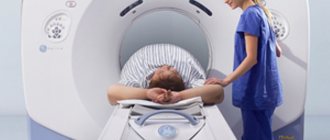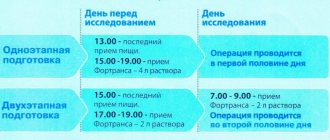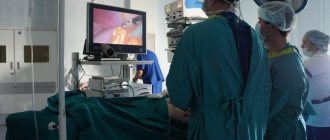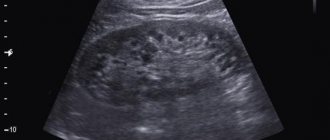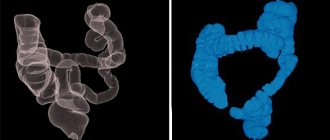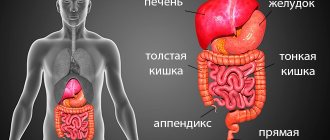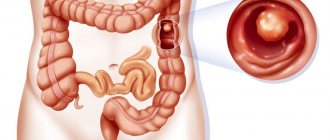Colon sigmoidoscopy (RRS) is the simplest, most accessible and highly informative endoscopic method for examining the terminal part of the colon. Intended for diagnosis and non-invasive treatment of the rectum and partially the sigmoid colon; if necessary, it is carried out for the purpose of examination by other endoscopic methods. Preparation for sigmoidoscopy begins 1-2 days before it is carried out, and consists of maximum cleansing of the rectum. Modern developments in medicine make it possible to identify almost all possible pathologies in different parts of the digestive system.
Sigmoidoscopy is an examination of the rectum using a special device with an optical system. Thanks to optics and illumination, a visual examination of the mucous membrane of the rectum and partially the sigmoid colon is carried out. If necessary, biopsy material is taken for microscopic examination, and simple operations are performed to remove polyps and stop local bleeding. It can become a preliminary study before carrying out other diagnostic procedures - irrigoscopy, colonoscopy.
Indications and contraindications
The procedure is intended to diagnose various diseases of the final sections of the colon. It is prescribed by a coloproctologist after a preliminary examination of the patient and digital examination. The reasons for the study are:
- intestinal dysfunction (IBS - irritable bowel syndrome, manifested by bowel dysfunction in the form of constipation or diarrhea);
- chronic course of hemorrhoids for timely identification of internal nodes and assessment of their condition;
- suspicion of a malignant tumor or polyps of unknown etiology;
- signs on the basis of which prostate cancer is suspected in men, and various neoplasms in the pelvis (fibroids, cysts) in women;
- pathological discharge from the anus (blood, pus, mucus).
The rectoscopic examination method is low-traumatic, but there are relative contraindications to its use:
- condition after vascular accidents (heart attack, stroke), severe respiratory failure;
- acute hemorrhoids, colitis, proctitis, paraproctitis, bleeding anal fissures;
- observation by a psychiatrist, convulsive syndrome.
There are no absolute contraindications to diagnostics.
If at least one of the contraindications is present, the study is temporarily postponed. Treatment is carried out to normalize the condition. If urgently necessary, the procedure is performed with great care, with preliminary anesthesia, in a gentle position, lying on the left side.
How is sigmoidoscopy performed?
RRS is carried out in an equipped office using a special instrument - a sigmoidoscope. This is a device with a metal or flexible plastic tube of various diameters (1 cm, 2 cm), 25-35 cm long. The device is equipped with lighting and video systems, an eyepiece with special lenses, and an additional device with a bulb designed for pumping air. Thanks to the optical part, when conducting an examination, the endoscopist makes a detailed analysis of the condition of the mucous membrane of the rectum and end of the sigmoid colon, assesses color, smoothness, shine, and integrity. For better visualization and further unhindered passage of the probe, the intestine is straightened with air, which the doctor pumps manually. To examine children, children's rectoscopes with a small tube diameter are used.
The flexible version of the sigmoidoscope is more comfortable. It causes less discomfort because it is soft, has a smaller diameter than metal, and is practically not felt when passing through the intestine.
Modern devices for performing RRS with fiber optics have the ability to display a color image on the screen and receive a video of the manipulation being performed for viewing. Video rectoscopy technology allows you to see in detail the relief of the mucous membrane, defects and neoplasms, evaluate the color, and the presence of swelling due to inflammation. Under the control of the image on the screen or the optical part of the device, simple manipulations can be carried out (taking biopsy material, removing a polyp or node, coagulation of an identified bleeding vessel, local administration of a drug, bougienage of the intestine in case of mild narrowing in a certain area, removal of a foreign object).
How to perform this rectal examination
Sigmoidoscopy is performed in an office equipped with special equipment. As a rule, you do not need anesthesia to perform this manipulation. However, in certain cases, local anesthesia is acceptable. So, for example, if the patient has an anal fissure or some traumatic damage is observed in this place. At the patient's insistence, it is very rarely possible to use intravenous anesthesia.
Before starting this procedure, the doctor performs a digital rectal examination. To do this, the patient must take a knee-elbow position; he is allowed to lie on his left side. After thoroughly lubricating the anal canal, a rectoscope tube is inserted four to five centimeters. Then, to smooth out the folds of the mucous membrane, air is pumped into the rectoscope tube.
The doctor explains to the patient that during the advancement of the device, the urge to empty the rectum may occur. During the examination, an electric suction is used; it is necessary to remove mucus, liquid feces and blood. During rectoscopy, during the period of air injection, the patient may experience pain in the lower abdomen or some discomfort. If the diagnosis brings sufficiently strong painful sensations to the patient, it is stopped.
Preparation
It is necessary to prepare for rectal rectal rectoscopy in advance. Preparation begins 3-4 days before the scheduled manipulation: it depends on the duration of constipation and its severity, on the phase of hemorrhoidal disease and other pathologies. During this time, the intestines are cleansed using:
- diets;
- cleansing enemas;
- laxative medications.
The diet that is prescribed to the patient these days in order to prepare the intestines for the procedure is reduced to the exclusion of foods that enhance the process of gas formation and irritate the mucous membrane. The diet should be slag-free.
At home, bowel cleansing must be done carefully, otherwise during examination you may not see a polyp or hemorrhoid due to fecal residues on the intestinal walls. For this purpose, cleansing enemas and laxatives are used. The doctor will decide which method is better for the patient to use for better preparation. He will advise effective laxatives, the frequency of their use and dosage. At the appointment, the patient is given a memo containing a list of:
- prohibited foods that are not recommended to be eaten for several days;
- drugs individually suitable for intestinal cleansing;
- performing enemas, the order of their implementation.
Features of the preparatory stage
Preparing the patient for sigmoidoscopy is carried out with the aim of freeing the necessary parts of the intestine from feces. If you do not take the necessary measures, the sigmoidoscope simply will not enter the intestines and the session will have to be rescheduled. Often all manipulations are carried out at home. The doctor simply warns the patient what he can or cannot eat and drink, and what procedures should be carried out immediately before the session.
Dietary rules in preparation for examination
At least 2 days before the proposed examination, you need to make changes to your usual diet. This is shown even to those people who adhere to healthy or dietary rules in everyday life. A good specialist will create a menu for the patient himself, based on the characteristics of his condition.
A slag-free diet before sigmoidoscopy looks like this:
| Can | It is forbidden |
| Fermented milk products with low fat content. | Products rich in dietary fiber, especially fresh. These are legumes, beets, cabbage, carrots, greens. |
| White bread crackers, dry biscuits. | Bread made from bran and wholemeal flour, baked goods, sweets. |
| Dried fruits and compotes made from them. | Some fruits: citruses, apricots, bananas, peaches and apples. |
| Meat broths cooked in second water. | Porridge made from oatmeal, pearl barley and buckwheat. |
| Dietary fish, white meat. | Fatty fish, red meat. |
| Green and herbal teas, fermented milk drinks. | Carbonated drinks, black coffee, alcohol. |
| Products steamed, boiled, baked in the oven. | Any fried foods, semi-finished products, fast food. |
On the eve of the procedure, in the afternoon, only the lightest meals are allowed. In the evening, drink only green tea or water. . On the morning of the examination, you should even refrain from breakfast.
Despite the long journey of food along the tract, eating before sigmoidoscopy is strictly prohibited
Colon cleansing with enemas
Without fail, preparation for the procedure involves cleansing the work area with enemas. In the intestines of any person, even if he prepares according to all the rules, there will be food residues due to which the examination may be disrupted. The first of two cleansing approaches is carried out in the evening, on the eve of sigmoidoscopy, and consists of two stages with an hour interval. The second - in the morning, a couple of hours before the manipulation, until a clean washing liquid is obtained. A single dose of the administered volume of water should not exceed 1-1.5 liters.
Medicinal bowel preparation methods
Today, increasingly, preparation for the study of the large intestine is carried out through the use of special preparations. Some of them are taken orally, others are applied rectally. If the procedure is prescribed by a doctor, then the method of preparation for it should be established by the same specialist. You should not change the proctologist’s appointments on your own; this can lead to negative consequences.
Most often, the patient is prepared in one of the following ways:
- Preparation for sigmoidoscopy with Microlax. The product is produced in special tubes and is administered rectally. A person preparing for an endoscopy session should administer two portions of Microlax with a 20-minute break the evening before the procedure and repeat these steps in the morning.
- Preparation for sigmoidoscopy with Fortrans. Most often, the preparatory stage is carried out with the help of Fortrans. To do this, take one sachet of medication, dilute its contents in a liter of boiled water at room temperature and drink in small sips. For high-quality sigmoidoscopy, preparation involves using 4 liters of Fortrans solution. The volume can be divided into 2 times, taking the product in the evening and in the morning - no later than 4 hours before the session.
- If the above drugs are not suitable for some reason, preparation can be carried out with the help of Levacol. Some people prefer to take Forlax, a powder that is suitable even for children. A specialist should calculate the doses of products taken.
The use of the listed products does not mean that you can leave your diet unchanged - a diet is necessary in any case. Having prepared properly for endoscopy, you can count on the absence of unpleasant sensations during the examination and minimal risks of side effects.
Possible complications after the procedure
Complications after sigmoidoscopy are rare. But in rare cases, despite the safety of the method, the following are possible:
- perforation of the rectal wall;
- bleeding after biopsy, polypectomy, removal of hemorrhoids.
Sometimes the patient is bothered by:
- pain in the abdomen;
- increased gas formation;
- nausea.
But these symptoms pass quickly. There are cases when pain is accompanied by bleeding. This is due to damage to the mucosa during the diagnostic procedure. The intestinal mucosa may also become inflamed after rectoscopy. The appearance of blood should be reported to the doctor. If necessary, a specialist will prescribe treatment.
The most dangerous complication is perforation, when the intestinal wall is damaged if carried out carelessly. Its contents enter the pelvis and abdominal cavity. If pain, high fever, nausea and vomiting occur, the patient is transferred to the surgical department and urgent surgery is performed. It is extremely rare.
What it is
Sigmoidoscopy is one of the endoscopic examination methods that can be used to diagnose intestinal pathologies.
Characteristic symptoms of varicose veins of the rectum are pain in the anus, bleeding during bowel movements and the sensation of a foreign body.
This procedure is an important stage of any proctological study. With the help of rectoscopy, it is possible to make an accurate diagnosis, assess the degree of neglect of the disease and the presence of concomitant pathological changes in the organ.

